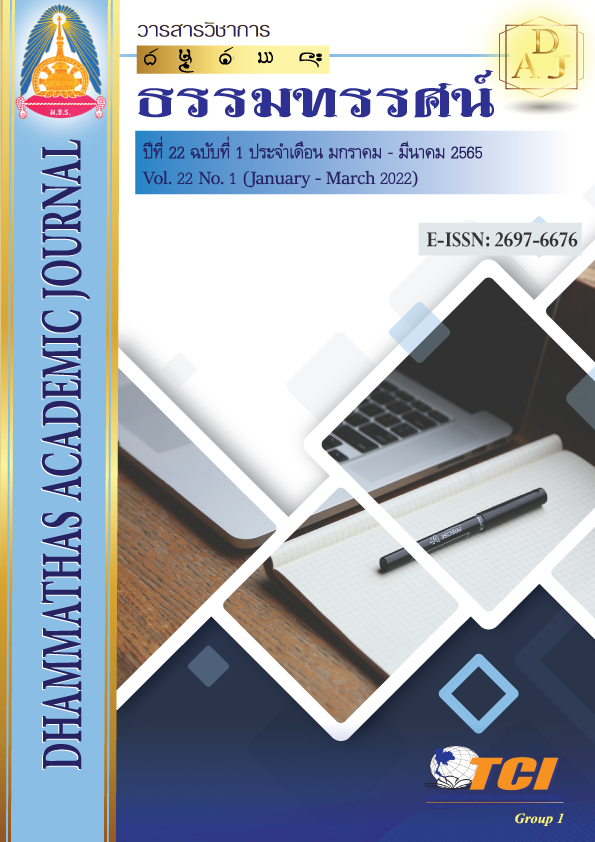The Impact on New Normal Communities of the COVID-19 Pandemic Situation in Chaiyaphum Province
Main Article Content
Abstract
The purposes of this research was to study the impact on new normal communities of the COVID-19 pandemic situation in Chaiyaphum Province. The research population was the people living in Chaiyaphum Province. For the quantitative research, the instrument was the questionnaire distributed to 400 households. Data were analyzed by percentage.
The results can be concluded as follows: The impacts on new normal communitiesare as follows. 1) Physical and mental healthimpact: they have stress and anxiety in living life75.75 percent. 2) Economyimpact: the villagers have to stop working or get laid off and gain lower income, and it is difficult in working 73.75 percent. 3) Perception of information and technology impact: they communicate through social media: Having problems with physical and mental health from anxiety 69.75 percent. 4) Society and environmentimpact: family members can get together; the community has changed the form of merit making and tradition activities in the new normal ways 64.75 percent. 5) Educationimpact of online learning causes an increase in the cost of learning materials. Poor families are severely impact: 52.75 percent.
Article Details

This work is licensed under a Creative Commons Attribution-NonCommercial-NoDerivatives 4.0 International License.
เพื่อให้เป็นไปตามกฎหมายลิขสิทธิ์ ผู้นิพนธ์ทุกท่านต้องลงลายมือชื่อในแบบฟอร์มใบมอบลิขสิทธิ์บทความ ให้แก่วารสารฯ พร้อมกับบทความต้นฉบับที่ได้แก้ไขครั้งสุดท้าย นอกจากนี้ ผู้นิพนธ์ทุกท่านต้องยืนยันว่าบทความ ต้นฉบับที่ส่งมาตีพิมพ์นั้น ได้ส่งมาตีพิมพ์เฉพาะในวารสาร วิชาการธรรม ทรรศน์ เพียงแห่งเดียวเท่านั้น หากมีการใช้ ภาพหรือตารางของผู้นิพนธ์อื่นที่ปรากฏในสิ่งตีพิมพ์อื่นมาแล้ว ผู้นิพนธ์ต้องขออนุญาตเจ้าของลิขสิทธิ์ก่อน พร้อมทั้ง แสดงหนังสือที่ได้รับการยินยอมต่อบรรณาธิการ ก่อนที่บทความจะได้รับการตีพิมพ์References
กฤษฎา บุญชัย และคณะ. (2563). รายงานฉบับสมบูรณ์ การวิจัยเรื่อง การประเมินความเสียหายผลกระทบและปรับตัวของชุมชนท้องถิ่นต่อภาวะโรคโควิด-19. เข้าถึงได้จาก https://www.ldi.or.th/wp-content/uploads/2020/11/Research_COVID.pdf
กรมควบคุมโรค. (2563). รายงานข้อมูลสถานการณ์การติดเชื้อโควิด-19 ประเทศไทย. เข้าถึงได้จาก https://ddc.moph.go.th/viralpneumonia/index.php
จุฑาทิพย์ จันทร์ลุน. (2563). พฤติกรรมสารสนเทศในยุคโควิด-19. วารสารห้องสมุด, 64(2), 36-49.
จันทนี เจริญศรี. (2563). บทวิเคราะห์ 7 New Normal ที่อาจได้เห็นในสังคมไทยในวันที่โควิด-19 หายไป. เข้าถึงได้จาก https://www.pptvhd36.com/news/ประเด็นร้อน/124543
บุญมา สุนทราวิรัตน์. (2563). โควิด-19 แนวทางการดำเนินงานและผลกระทบระดับพื้นที่จังหวัดเลย ประเทศไทย. วารสารวิชาการสาธารณสุขชุมชน, 7(1), 16-34.
พิริยะ ผลพิรุฬห์. (2563). ผลกระทบทางเศรษฐกิจจาก “ไวรัสโควิด-19”. เข้าถึงได้จาก https://www.posttoday.com/finance-stock/columnist/618563
ศันสนีย์ กระจ่างโฉม และคณะ. (2564). กลยุทธ์การปรับตัวของภาคการท่องเที่ยวในภาคเหนือตอนบนภายใต้วิกฤติการณ์การระบาดโควิด-19. วารสารวิชาการมหาวิทยาลัยหอการค้าไทย มนุษยศาสตร์และสังคมศาสตร์, 41(1), 1-20.
ศรุตานนท์ ชอบประดิษฐ์. (2563). วิกฤตโควิด 19 ส่งผลกระทบต่อการเปลี่ยนแปลงทางสังคมอย่างไร. วารสารชัยภูมิปริทรรศน์, 3(2),1-14.
สำนักงานการวิจัยแห่งชาติ. (2563). รายงานข้อมูลสถานการณ์การติดเชื้อโควิด-19 ประเทศไทย. เข้าถึงได้จาก https://www.nrct.go.th›news›
องค์การอนามัยโลก. (2563). โรคติดเชื้อไวรัสโคโรนา 2019 (COVID-19). เข้าถึงได้จาก https://ddc.moph.go.th/viralpneumonia/ind_world.php
